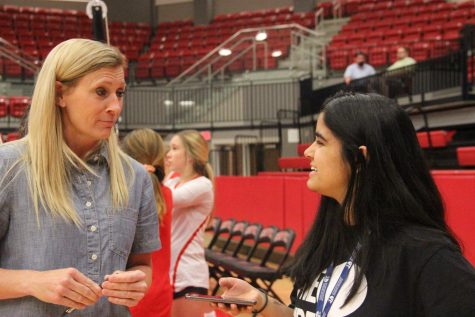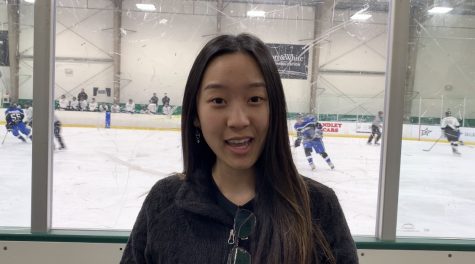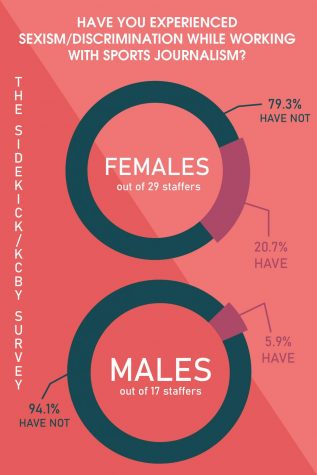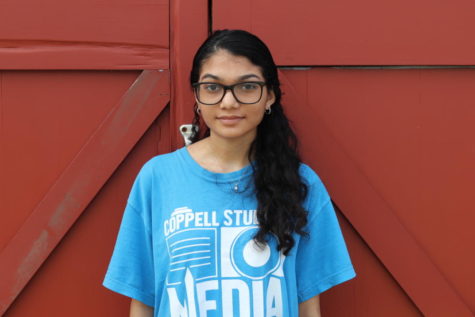Pushed to the sidelines
Female sports journalists still seeking respect in fight for equality
For decades, women have dealt with sexism and discrimination in sports journalism. The Sidekick executive sports editor Sally Parampottil recognizes this issue and brings attention to sexist harassment and objectification of women in the field.
March 25, 2020
Google “female sports journalists” and look at the first page of results.
Of the nine results, four of them are about the struggles of being a woman in sports journalism. Two showcased female reporters who had made great strides for their gender in the world of sports, though each inevitably had a good portion of space dedicated to talk of sexism and discrimination as well. Two ranked female sports reporters by their looks.
One, titled “The Best Female Sports Reporters”, had me hoping for a site finally looking at women for their accomplishments beyond just being a woman in a male-dominated industry.
Then I noticed the URL.
“https://www.mensjournal.com/sports/15-hottest-female-sports-reporters-industry/”
And I noticed the tag at the bottom of the page.
“Hot girls”
Make that three.
While change is, of course, a process with many stages to be seen, the process of normalizing women in sports journalism seems to be stuck in a spot where women are seen as either novelties or eye-candy – not independent women who have accomplished more than breaking through a gender barrier.
The recognition given to the pioneers of female sports journalism is rightfully given, as they made great strides in progress for their gender. However, there comes a point where we need to stop seeing female sports journalists as anything other than normal.

Coppell coach Julie Price is interviewed by The Sidekick CHS9 editor Shivi Sharma on Sept. 13 in the CHS Arena following the Coppell volleyball team’s sweep of Irving Nimitz. Sharma is one of many female staff writers who contribute to The Sidekick’s sports section.
A part of the problem is the simple fact that there are not as many women in the industry as men. However, that can be attributed to more than just the idea that only men go into sports journalism.
“People associate males with sports, so when you’re picking a broadcaster for football or basketball or baseball, you automatically assume a male is going to be covering it,” Coppell High School junior KCBY sports director Anabelle Sigman said. “For women in journalism, they have to fight harder to gain the spot and the respect they deserve. Even though we’re all covering the same stuff, it’s seen that men are more knowledgeable in the sport.”
Sports journalists across the board on a professional level have to put up with backlash, it simply comes with the job. However, women in the industry can face sexist harassment in addition to general negative comments. In a powerful video, the podcast group Just Not Sports had men read real mean tweets to the faces of the female sports journalists. The tweets were increasingly worse, making sexist remarks about hiring and going so far as to wish death and rape on the women who were simply doing their jobs.
Many of the comments I cannot even repeat in this article – comments men would most likely never hear.
“I, for one, have watched college softball because that’s the sport I play and I see broadcasters who are men and nobody says anything,” said Sigman, also a catcher on the Coppell softball team. “Then, if we’re watching football or baseball and there’s a female broadcaster, people assume, ‘Oh, she’s trying to get with all of the guys, she’s trying to portray herself as someone she’s not.’ It’s a different view because we’re women and working with men versus men working with men. We aren’t put in the same shoes, basically.”
An additional problem is when women are not facing blatant sexism through hatred, they might also be facing sexism disguised under the pretense of compliments. Through the numerous articles listing the hottest sportscasters or sideline reporters, it is clear that women who find a place in the sports media world can very easily be objectified and reduced to a pretty face put on screen to satisfy male viewers.
Canadian hockey analyst Jim Parsons, in his list of hottest sports broadcasters of all time (shockingly all female), said “…an audience comprised of mostly males doesn’t mind watching coverage from former athletes. But, an audience of mostly males also doesn’t mind watching a good looking female every now and again as well.”

The Sidekick senior staff writer Sarah Woo gives her post-game wrap-up following the Coppell hockey team’s 6-3 loss to Mansfield on Jan. 23 at the Children’s Health StarCenter in Farmers Branch. Woo is one of many female staff writers who contribute to The Sidekick’s sports section.
Interesting how you watch coverage from the men but not from the women. You just watch the woman when it is a woman.
Parsons goes on, saying, “Basically, it’s every man’s dream — a woman who loves sports and is fine as the day is long.”
Ew.
Parsons did not respond to a request for an interview.
While I can understand companies want to appeal to their viewers, there is a clear line between that and objectifying women. That line is drawn when women are no longer people beyond their looks, when their actual accomplishments are overshadowed by the fact that they have sex appeal.
With the combination of the uphill climb to begin, the sexist harassment and the objectification, it is no surprise that women are not inclined to gravitate to sports journalism – myself included. With paper-thin skin, I would not be able to handle a fraction of hate comments the female sports journalists are subject to, despite my adoration of sportswriting.
It does not have to be like this.
As the executive sports editor of a hyper-productive sports section, I am proud to say a large portion of my section’s content comes from female writers. I have seen girls flourish in the sports section.
Sigman and I took a survey of staffers of our respective programs who worked for sports asking if they had experienced any form of sexism while doing sports work. Of the 26 responses I received from Sidekick female staff writers who had written for sports this school year, 23 of them had not.

The Sidekick executive sports editor Sally Parampottil and KCBY sports director Anabelle Sigman conducted a survey by asking staffers if they have experienced sexism while writing for sports journalism. Parampottil brings attention to how a reduction in such sexism at the high school level allows for more women to be comfortable in the field.
On a high school level, it appears to be much easier for a girl to be comfortable with sports writing.
The fears I faced when first writing for sports last year dissolved when I did not face backlash from athletes, coaches or parents due to what I wrote. I was not talked down to, I was not treated with anything other than respect, and I found myself adoring the sports section enough to apply for the sports editor position.
As a female sports editor, I also worried I would not be taken as seriously due to my gender. Once again, those fears went away when I was respected just the same. Being a girl in a leadership position in sports was something huge for me, and The Sidekick’s sister program is seeing similar things with its sports leadership.
“For KCBY specifically, we have two sports directors, me and another girl [CHS junior Laura Boylan],” Sigman said. “This is the first year we’ve had two girls doing it. The rest of our staff is mainly males in our class so it’s very different having us in the leadership position versus just normal staff.”
If the rest of the world could simply get to the high school level, perhaps we would have more women in the sports media industry and normalize the existence of female sports reporters.
Of course, the high school level is not perfect – there were still three Sidekick girls who had experienced sexism on the job compared to the results of the male version of the survey, in which all 10 male Sidekick staff writers who had written for sports had not experienced sexism on the job. Similarly, the world will never truly be a welcoming environment, not entirely, to female sports journalists.
However, it is a step in the right direction.
My message to everyone who consumes sports media is this:
Do not ask my writers if they are actually experienced enough to cover an event and do not insinuate that it might be a better idea to send a boy instead. Do not ask my writers if the male athlete they are interviewing is their boyfriend. Do not treat female sports reporters, high school or professional, like they are inferior, like they are nothing more than makeup and hairspray or in any way to discourage their participation in what they love to do.
And until the world can heed my message, my hopes for the world of sports media are sustained by the attitudes of women with thicker skin than my own, women who look sexism in the eyes and laugh.
Women like the one anonymous participant of the survey who faced sexism and, when asked if the experience would dissuade her from writing sports again, texted me with full confidence, “Sexist bigots won’t be deterring me anytime soon.”
Follow Sally (@sparampottil) and @SidekickSports on Twitter.














nanette pottoore • Mar 27, 2020 at 11:36 am
sally I really loved this story, it shows how we still have so much to learn from and that discrimination is still prevalent. your words hold so much emotion to them and I love it.
Victoria Hertel • Mar 26, 2020 at 1:26 pm
Wow Sally, this story had me on the verge of tears. Your writing is so true and powerful.
Anthony Cesario • Mar 25, 2020 at 8:01 pm
Absolutely amazing column Sally!!! Those last two paragraphs are pure art